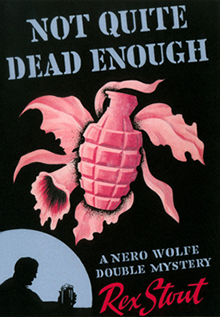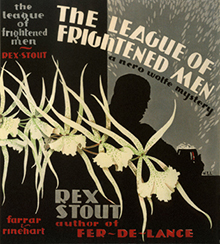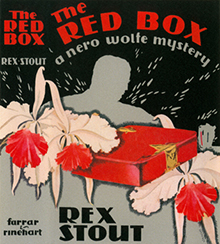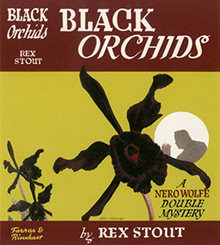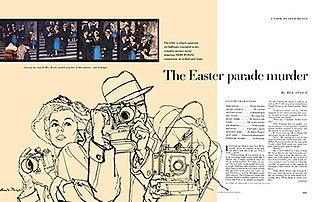Plot summary
The dick got out his memo book and wrote it down. "I don't think it was deliberate," he said. "I think she just changed her mind. I think she just – "
"You think? You say you think?"
"Yes, Inspector, I – "
"Get out. Take another man, take Dorsey, and go to that address and look into her. Don't pick her up. Keep on her. And for God's sake don't think. It's repulsive, the idea of you thinking."
— Inspector Cramer to a subordinate, in "Black Orchids"
"Rose hid among the shrubs and watched the door"
Millionaire orchid fancier Lewis Hewitt has hybridized three black orchid plants in his Long Island greenhouse. Nero Wolfe is wild to have one, so he and Archie Goodwin visit New York's annual flower show, where Hewitt's orchids are on exhibit. One of the other exhibits features a daily performance by a young couple miming a summer picnic. The woman, Anne Tracy, attracts the attentions of Archie, Hewitt, and a young exhibitor named Fred Updegraff.
During Wolfe's visit to the show, Anne's picnic partner Harry Gould is killed, shot in the head by a gun concealed in the foliage. The gun's trigger is attached to a long string that reaches to a hallway well behind the exhibit.
After a little inquiry, Wolfe shows Hewitt how his walking stick was used to pull the string and fire the shot that killed Gould. Hewitt is horrified by the prospect of the publicity that would ensue should his part in the shooting, however indirect and unwitting, become known. Wolfe offers Hewitt this arrangement: in exchange for all three black orchid plants, the only ones in existence, Wolfe will solve the murder and deliver the criminal to the police, without publicly disclosing Hewitt's connection to the crime. Hewitt terms it blackmail, but submits.
Earlier, Archie had noticed a woman waiting in the hallway behind the exhibit, at around the time that the murderer would have been deploying the string. He now finds her in the crowd that's gawking at the murder scene. Archie steals her handbag, removes it to the men's room, searches it for identification, and learns her name (Rose Lasher) and address. He returns the handbag to her – all without Rose or anyone else noticing.
The police want to know more about her and, finishing their questions, they let her go — but surreptitiously follow her. The police lose her trail but Archie knows her home address, where she has been living with Harry Gould. He arrives at Rose's apartment just as she is about to flee the city, and takes her to Wolfe's house. There Archie searches her suitcase and finds some printed matter that Rose cannot or will not explain: a clipping of an article by Hewitt on Kurume yellows, [lower-alpha 1] a plant disease that is fatal to broadleaf evergreens; a postcard to Rose from Harry, postmarked Salamanca, New York (in the western part of the state); and a work order from a garage, also in Salamanca.
Wolfe gets Rose to discuss some of Gould's unsavory qualities. Wolfe learns that although Gould was employed as a gardener, he suddenly acquired a bank account containing several thousand dollars [lower-alpha 2] and what Miss Lasher terms "a big roll of bills." From his general awareness of horticultural events, Wolfe knows that an attack of Kurume yellows devastated a plantation of a new hybrid of broadleaf evergreens, about eighty miles west of Salamanca and owned by Updegraff Nurseries. The same disease has affected the exhibit in which Anne and Gould were featured; W. G. Dill, one owner of the company sponsoring it, had asked Wolfe to investigate the source.
Weighing all this information, Wolfe assembles the principals in the fumigation chamber of his plant rooms. He accuses Hewitt of conspiring with Gould to infect the plantations of rival growers, and of killing Gould after the latter began to blackmail him. When a telephone call comes in for Hewitt, Wolfe sends Dill to answer it instead, closes the chamber door, and informs the rest of the group that Dill, not Hewitt, is the murderer. Dill is later found dead in the plant rooms, having turned on the flow of fumigation gas with the intent to kill everyone inside the chamber; however, Wolfe had anticipated this action and diverted the gas to fill the plant rooms instead.
Wolfe tells Cramer that Anne had previously confirmed his suspicions of Gould's and Dill's activities. He keeps the black orchids, but Cramer is unimpressed by their appearance, saying that he prefers geraniums. The orchids have a cameo role in the second novella in this collection, "Cordially Invited to Meet Death."
Wolfe tells Johnny Keems that “Contact is not a verb…” Modern references in the text include the Empire State Building, Helen E. Hokinson, a cartoonist at the New Yorker and, Billy Rose, who wrote It’s Only a Paper Moon.







